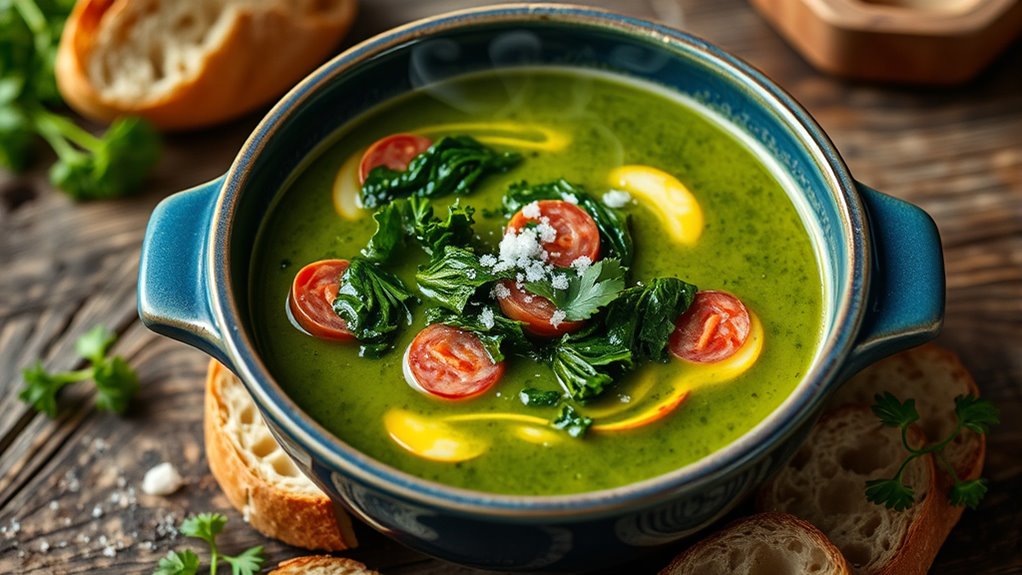A Portuguese soup you can make confidently uses a base of broth, tomatoes, aromatics, and a mix of vegetables with legumes for protein. Start by sautéing garlic and onion, then add broth, diced carrots and potatoes, tomatoes, and seasonings like smoked paprika, salt, and pepper. Maintain a gentle simmer until vegetables are tender and flavors meld. This approach emphasizes balance, texture, and nutrient density, with potential variations to suit your pantry—continue and you’ll uncover more sustainable flavor tactics.
Ingredients and Quantity

The Ingredients and Quantity for this Portuguese soup are listed precisely to guarantee consistency: 4 cups of broth, 1 cup of chopped tomatoes, 2 cloves of garlic, 1 medium onion, 2 tablespoons of olive oil, 1 teaspoon of smoked paprika, 1/2 teaspoon of salt, 1/4 teaspoon of black pepper, and 2 cups of diced vegetables (carrot and potato).
| Category | Standard Amount | Purpose |
|---|---|---|
| Core liquid | 4 cups broth | Baseline consistency |
| Aromatics | garlic, onion | Flavor foundation |
| Seasoning | paprika, salt, pepper | Balance and heat |
| Veg count | 2 cups | texture, nutrition |
This formulation supports soup varieties and allows ingredient substitutions without compromising structure or clarity.
Preparations
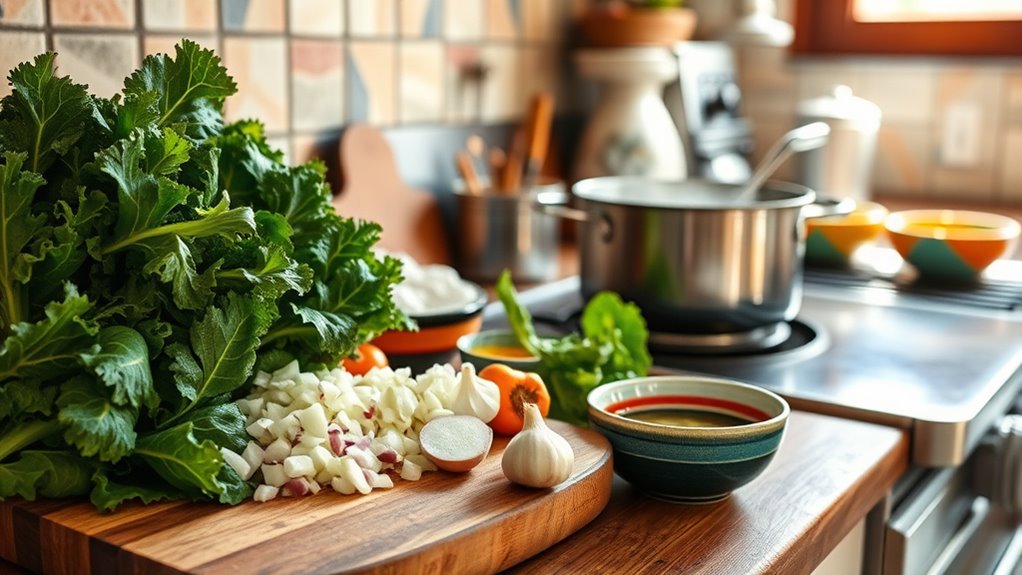
Begin by washing and preparing all produce: rinse the vegetables under cold water, peel the onion and garlic if desired, and dice the carrot and potato into uniform pieces. You then assess freshness and trim any blemishes, ensuring consistent size for even cooking. Use methodical, evidence-based steps: soak dried beans if included, rinse rice or grains, and measure portions to maintain reproducibility. For vegetables, chop into uniform cubes or slices to optimize heat transfer and texture. Implement preparation techniques that support flavor release without overcooking: preheat the pan, bloom aromatics briefly, and add liquids at controlled simmer. Monitor salt and fat levels per taste, and adjust seasoning after initial tasting. This approach supports flexible soup variations while maintaining precision and clarity.
Kitchen tools or Kitchenware Required
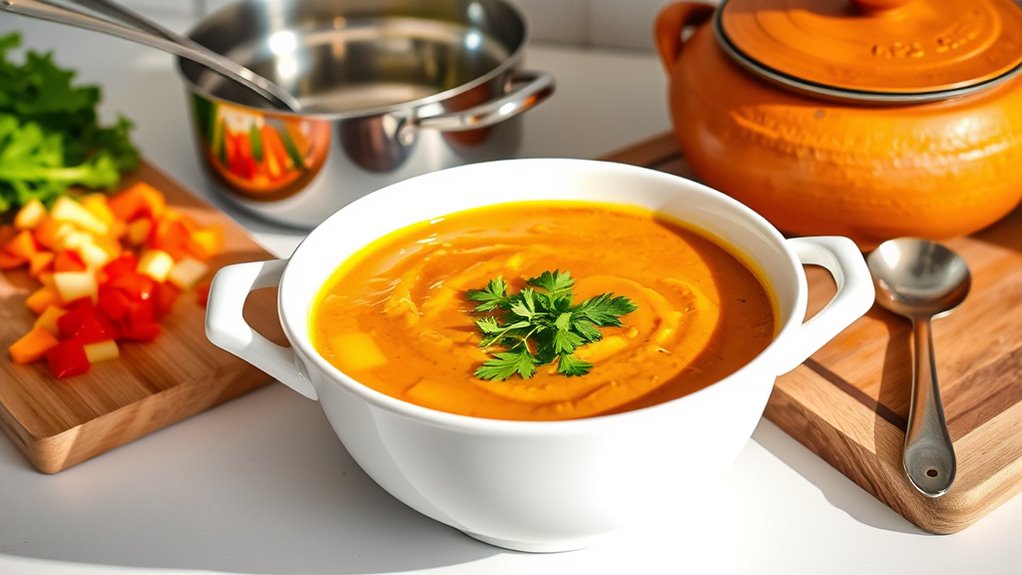
You’ll need a minimum set of dependable tools to guarantee consistent results: a large, heavy-bottomed pot (6–8 quarts) for even heat distribution, a sharp chef’s knife, a cutting board, and measuring cups and spoons for reproducible portions; optional but helpful items include a colander for washing produce, a wooden spoon for gentle stirring, and tongs for handling hot components.
| Tool | Purpose | Benefit |
|---|---|---|
| Soup ladle | Portioning | Consistent servings |
| Cutting board | Prep surface | Safe, quick slicing |
| Measuring cups | Accuracy | Reproducible quantities |
| Pots | Heating | Even distribution |
| Knife | Cutting | Precision control |
How to Cook
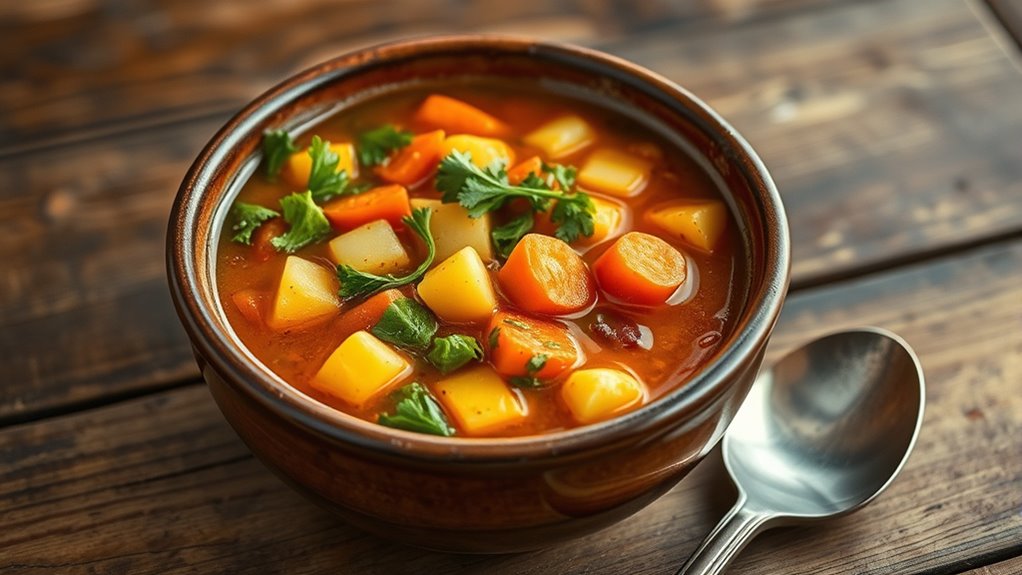
- Assemble all ingredients before starting.
- Heat a pot over medium heat and add a light coating of oil.
- Sweat aromatics until they become translucent.
- Add broth and diced vegetables to the pot.
- Maintain a steady simmer, avoiding a full boil to preserve texture and flavor.
- Introduce starches or legumes at the appropriate times for even cooking.
- Use controlled heat to prevent scorching, stirring only when necessary to avoid sticking.
- Season gradually with salt, pepper, and herbs, tasting after each addition.
- Keep track of cooking times to ensure consistent results across portions.
- Focus on techniques that optimize nutrient retention and enhance mouthfeel while considering personal taste.
- Experiment with variations by rotating greens, legumes, and grains within safe and tested limits.
How to Serve
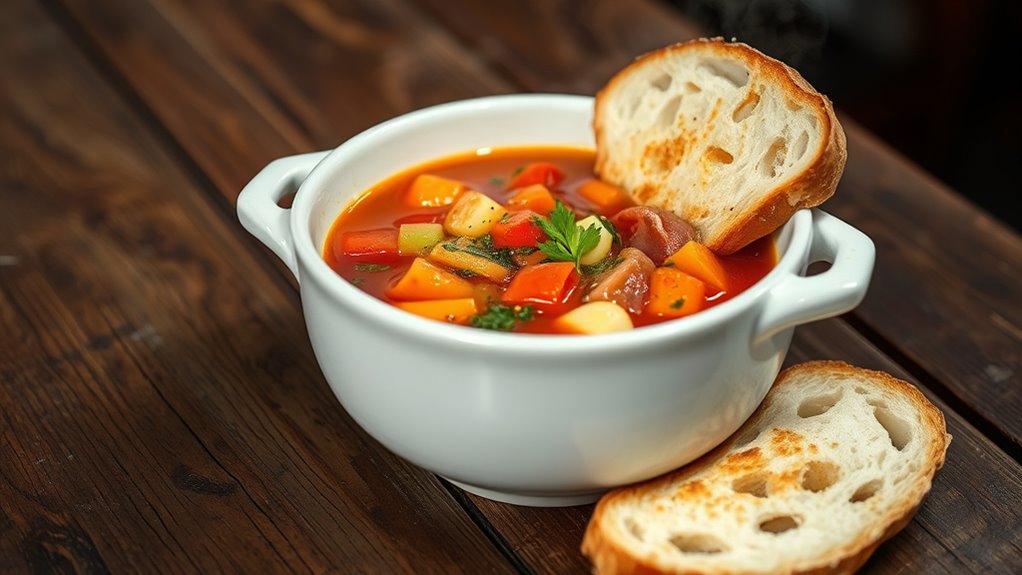
Serving a Portuguese soup effectively centers on temperature, texture, and accompaniment. You should aim for a consistent serving temperature, ideally warm rather than scalding, to preserve delicate aromatics and balance flavors. Texture matters: offer a spoonable broth with tender vegetables and meat, ensuring each bite delivers cohesion, not mush. Accompaniment choices influence perception; select crusty bread, rustic rolls, or soaked milho fôrmo to complement starches without masking savor. Garnish options, such as a light drizzle of olive oil, chopped herbs, or a pinch of paprika, can enhance aroma and appearance without altering core flavor. Serving suggestions emphasize portion control, appropriate bowls, and clear presentation. Present soups promptly after heating, with brief guidance on reheating limits and storage for peak quality.
Tips
Building on the serving guidelines, practical tips help you optimize flavor and texture in Portuguese soup. You should prioritize consistent simmering and timely ingredient addition to maintain structure and aroma. Use evidence-based practices: monitor sodium by tasting early, adjust with low-sodium stock, and rely on high-quality olive oil to finish for aroma. For soup variations, vary legumes, greens, and smoked meats to achieve distinct profiles without compromising cohesion. When applying cooking techniques, sear aromatics before simmering to intensify depth, and add delicate greens at the end to preserve color. Maintain calm heat to prevent breakdown of starches, ensuring body while avoiding mushiness. Document outcomes to refine your method, and tailor steps to personal preference for freedom within structure.
Food Value and Benefit
Portuguese soup provides substantial nutritional value through its thoughtful combination of ingredients. Made with legumes, a variety of vegetables, and a small amount of smoked lean meat, this dish offers a well-rounded macronutrient profile along with essential vitamins and minerals. The fiber-rich legumes and vegetables promote digestive health and satiety, while the smoked meat adds flavor and protein without excessive calories.
Portuguese soup combines legumes, vegetables, and lean smoked meat for a nutrient-rich, satisfying meal.
Benefits of eating this Portuguese soup include:
- Rich source of plant-based protein and complex carbohydrates from legumes, supporting sustained energy release.
- High in dietary fiber, which aids digestion and helps maintain fullness, contributing to weight management.
- Packed with vitamins such as vitamin A, vitamin C, and several B vitamins, which support immune function, skin health, and energy metabolism.
- Contains essential minerals including iron, potassium, magnesium, and calcium, which are important for oxygen transport, electrolyte balance, bone health, and muscle function.
- Low in saturated fat due to the use of lean smoked meat, enhancing nutrient density while keeping calorie intake moderate.
Frequently Asked Questions
Can I Make Portuguese Sopa With Gluten-Free Bread?
Yes, you can, using gluten-free bread. For best texture, choose gluten-free bread alternatives and adjust soaking time. Consider gluten free options like almond or rice cakes; monitor starch content to avoid sogginess.
Is There a Vegan Version of Portuguese Sopas Soup?
Yes—you can craft a vegan version using vegan broth and plant based proteins. You’ll substitute meat stock, cite evidence, and savor sensible substitutions, ensuring satisfying flavor while you pursue freedom with gluten-free, dairy-free, ethically sourced options.
How Long Does It Store in the Fridge After Cooking?
You’ll typically store cooked Sopas in the fridge for 3–4 days; guarantee airtight containment. For Sopa storage, avoid left at room temp beyond two hours. Soup longevity improves with rapid cooling and reheating only once.
Can I Freeze Portuguese Sopas Without Altering Texture?
You can freeze Portuguese sopas, but texture preservation depends on rapid freezing and proper packaging. Use freezing techniques like shallow portions, then thaw slowly in the fridge; avoid repeated freezing to maintain flavor and structure.
What Substitutions Work for Traditional Chouriço or Sausages?
You can substitute with smoked paprika, capicola, or turkey chorizo for similar smoky flavor; add mushrooms or tempeh as protein alternatives, ensuring balanced texture and salt. This evidence-based choice maintains savory depth and delivers controlled, satisfying nutrition.
